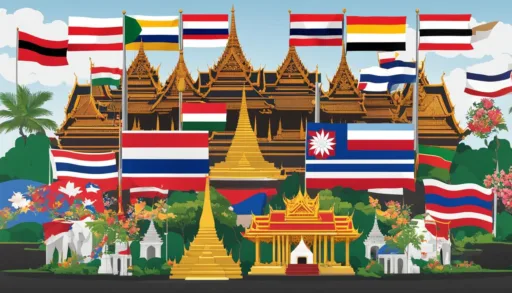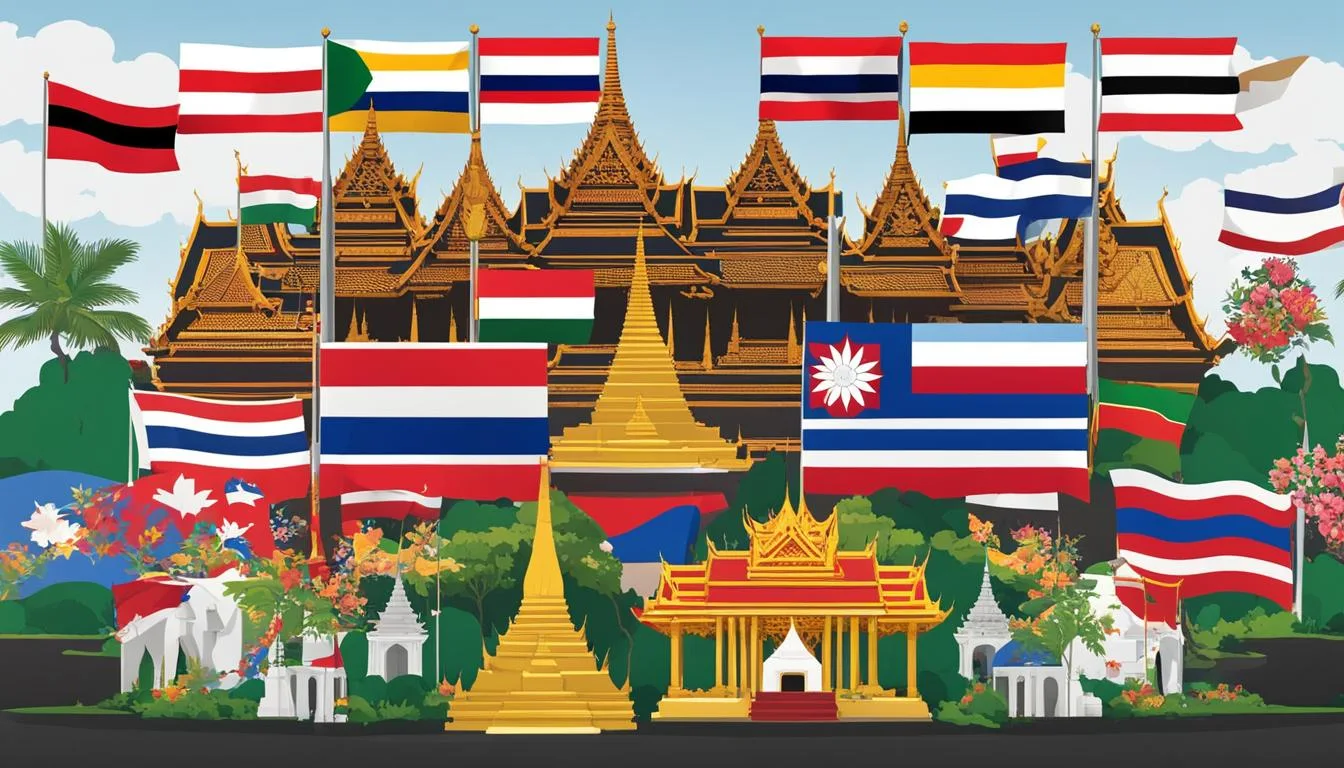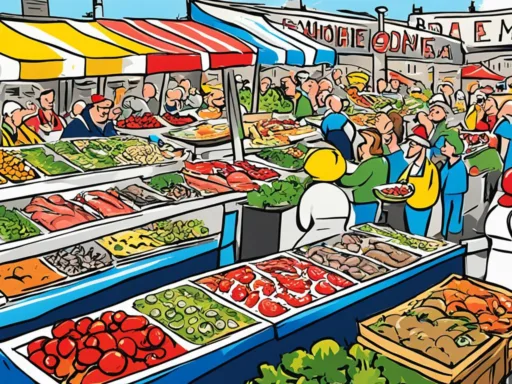The Kingdom of Thailand is home to a linguistic wealth much grander than many might expect—with more than 70 living languages, this Southeast Asian nation’s communicative landscape is as intricate and colorful as its famed silk weavings. Central Thai is the cornerstone, spoken fluently by a staggering 96% of the population, cementing its role both as the official tongue and the unifying thread among the diverse dialects of Thailand. Yet the country’s rich tapestry is woven with an array of vernaculars from Isan to Southern Thai, each distinctly reflecting the country’s complex cultural quilt.
Languages spoken in Thailand stem from its deep ethnic roots, hosting indigenous tongues such as Akha, Karen, and Malay, and embracing immigrant languages like Burmese and various Chinese dialects. A nation in conversation, Thailand speaks of tradition and adaptability in the voices that echo through its bustling cities and serene rice paddies—one cannot help but listen.
Key Takeaways
- Thailand is a multilingual nation with over 70 living languages contributing to its cultural diversity.
- Central Thai is the official language and holds prominence as the primary language for 96% of the Thai population.
- Regional dialects, such as Isan, Northern, and Southern Thai, showcase the geographical and cultural distinctions within the country.
- Minority and immigrant languages add depth to the linguistic landscape, revealing Thailand’s rich ethnic tapestry.
- The prevalence of Central Thai in education and government illustrates its critical role in upholding national unity.
Linguistic Diversity of Thailand
Thailand is celebrated for its vibrant cultural tapestry, a significant part of which is its complex linguistic landscape. With a population speaking various languages from the Southwest Tai family, Thailand epitomizes a truly multilingual society. The profound richness of languages extends beyond the commonly heard Central Thai, delving into the heritage of the region’s numerous ethnic groups.
Overview of Thailand’s Multilingual Society
The linguistic landscape of Thailand is dotted with a plethora of languages spoken across its geographical expanse. The core of this landscape is the omnipresent Central Thai language, serving as the nation’s lingua franca. However, this is just the tip of the linguistic iceberg. The border regions echo the regional dialects of Thailand, resonating with sounds of Lao in the northeast, the Karen language in the mountainous north, the ancient Khmer in the east bordering Cambodia, and Malay in the deep south adjoining Malaysia.
The Influence of Ethnic Diversity on Language
Ethnic diversity has sculpted Thailand’s multilingual identity. The official recognition of 62 regional ethnolinguistic groups by the Thai government underscores a commitment to embracing this diversity. Languages hailing from various families, including Kra-Dai, Austroasiatic, Sino-Tibetan, Austronesian, and Hmong-Mien, are daily fixtures in the lives of the Thai people. Indigenous and minority languages in Thailand, like Akha, Shan, and Vietnamese, color the cultural canvas and hold great significance within their communities.
| Language Family | Popular Languages | Regions Spoken |
|---|---|---|
| Kra-Dai | Thai, Lao, Shan | Central, Northeast, and Northern Thailand |
| Austroasiatic | Khmer, Mon | Eastern and Southeastern Thailand |
| Sino-Tibetan | Burmese, Karen | Western and Northern Thailand |
| Austronesian | Malay | Southern Thailand |
| Hmong-Mien | Hmong, Mien | Northern Thailand |
While Central Thai reinforces its position as the dominant popular language in Thailand, these various languages ensure a bustling mosaic reflective of the nation’s rich cultural and ethnic makeup. Particularly in the Northeast, a blend of Tai and Austroasiatic languages amplifies the region’s status as a melting pot of traditions and linguistic expressions, depicting a vast and contrasting linguistic landscape that is integral to the heart of Thailand.
Languages Spoken in Thailand
The cultural tapestry of Thailand is notably defined by its rich array of languages, where the melodious Thai language serves as more than just a means of communication—it’s an integral part of the nation’s identity. Embedded within its sonic diversity are the various dialects of Thailand, each adding a unique vibrancy to the linguistic landscape. From the bustling cities to serene villages, the symphony of tongues spoken throughout the country is as diverse as it is fascinating.
Central Thai, the official language, is ubiquitously spoken and understood. Its dominance, however, does not eclipse the significant regional languages that echo across the plains and hills. Northeastern plains resonate with the tones of Isan, akin yet distinct from the Central Thai, drawing its roots from the neighboring Lao language. Similarly, the Northern Thai language, or Kham Muang, carries the historical legacy of the Lanna Kingdom.
Not to be forgotten are the harmonious pitches of the Southern dialects, locally known as Pak Tai, which varies from the standard Central Thai in both vocabulary and pronunciation. These languages are not mere footnotes but are spoken by millions, underlining their critical role in everyday communication and cultural expression.
Thailand’s linguistic fabric stretches even further to include a multitude of minority and immigrant languages, preserving the essence of the country’s storied past and dynamic present.
Within various communities, you might encounter the vibrant Akha, the rhythmic cadence of Karen, or the soft melodies of Malay dialects, each bearing testament to the ethnic richness of Thailand. These community-specific languages are cherished threads in the national cultural tapestry, echoing through marketplaces, schools, and traditional ceremonies.
Adding texture to this linguistic mosaic are the voices of immigrants and expatriates. From the rolling r’s of Burmese to the tonal speech of Vietnamese, and the varied accents of Chinese dialects, they contribute to the ever-evolving languages spoken in Thailand. Drawn to its shores for myriad reasons, these individuals share their native tongues, weaving them intricately into the country’s social and economic fabric.
- Central Thai: The unifying national language
- Isan: A Lao-related language spoken in the northeast
- Northern Thai (Kham Muang): A Lanna language with a distinct literary tradition
- Southern Thai (Pak Tai): A language with lexical and pronunciation differences from Central Thai
- Akha, Khmer, Karen, and Malay dialects: Minority languages with deep local roots
- Burmese, Vietnamese, and Chinese dialects: Immigrant languages enriching Thailand’s diversity
Understanding Thailand’s linguistic diversity is to appreciate the complexities of its societal arrangement, where each spoken word carries the weight of history, the pulse of culture, and the potential for unity. Language in Thailand is not merely about dialects—languages spoken Thailand echo the essence of a nation that is as welcoming as it is complex, as traditional as it is rapidly modernizing.
The Official Language: Thai
At the heart of Thailand’s linguistic heritage is its official language, the Thai language, known regionally as Central Thai. This language acts as a unifying thread that weaves through the fabric of Thailand’s society, enabling communication across diverse communities and serving as the cornerstone of national identity.
Central Thai: The National Standard
Central Thai, sometimes referred to as Siamese, is the authoritative form of the Thai language officially utilized throughout the country. With a presence strongly felt in Central, Southwestern, and Eastern regions of Thailand, Central Thai also resonates within Thai Chinese communities. Evolving from the Khmer script and sharing linguistic connections with Lao and Shan, Central Thai embodies a deep communicative significance that underscores its historical lineage.
The Role of Thai in Education and Government
In the realms of education and government, the Thai language occupies a premier role. Mastery of Central Thai is a common thread that connects all Thais, encapsulating the language’s critical function in school instruction and civil governance. This language is not only a tool for daily communication but also the medium through which governmental policies are crafted and conveyed. By embracing Central Thai in official domains, Thailand reinforces the language’s pivotal place in the nation’s administration and education system, further entrenching it as the official language of Thailand.
Vernaculars and Regional Dialects
Thailand’s linguistic tapestry is as vibrant and diverse as its cultural heritage, with each region of the country offering its own unique verbal flavors. These regional dialects of Thailand are not just means of communication; they are also emblems of local identity and heritage. As we explore the nuances of languages spoken throughout the kingdom, we delve into the rich tapestry that comprises provincial dialects and the intriguing Thai language variations that occur from one locale to another.
Dialects in the Four Main Regions of Thailand
The regional dialects of Thailand showcase a country divided into four linguistic landscapes, each with its own distinctive sound. In the bustling streets of Bangkok and the paddy fields of Central Thailand, Central Thai reigns supreme, understood by all and serving as the lingua franca of the nation. Venturing north to the mountainous terrain of the former Lanna Kingdom, you’ll hear the melodic tones of Northern Thai, or Kham Muang. The Northeast, known widely as Isan, vibrates with the Lao-related Isan language, marking out its connection to Thailand’s neighbor Laos. Lastly, in the sun-drenched South, Pak Tai, or Southern Thai, carries the whispers of the seas and the stories of a maritime culture.
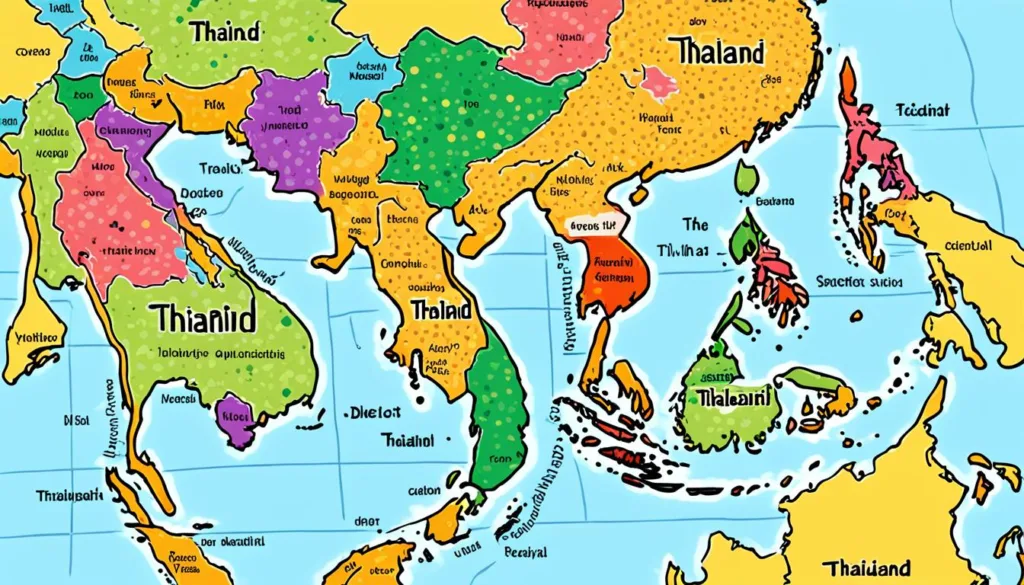
Unique Linguistic Characteristics Across Provinces
The provinces of Thailand are not just political boundaries; they are also linguistic markers that retain unique characteristics and an astonishing variety of provincial dialects. The Khmer-speaking populations in Buriram, Chanthaburi, and Surin provinces reflect centuries of culture and migration, while the prevalence of Lao in Sisaket hints at the province’s geolinguistic ties. These variations within the Thai language illuminate the depth of Thailand’s ethnic diversity and the dynamic interplay between cultures and languages.
| Region | Dialect | Characteristics |
|---|---|---|
| Central Thailand | Central Thai | Broadly understood; Standard for government and education |
| Northeast (Isan) | Isan Language (Lao-related) | Similar to Lao; Influenced by Khmer and Thai |
| Northern Thailand | Northern Thai (Kham Muang) | Melodic; Uses distinct vocabulary and script |
| Southern Thailand | Southern Thai (Pak Tai) | Uses long vowels; Influence from maritime culture |
Understanding these Thai language variations is essential for anyone looking to fully appreciate the cultural mosaic that is Thailand. As the voices of each region resonate with their own history and identity, they remind us of the power of language as the keeper of regional stories and traditions.
Minority Languages of Thailand
The cultural tapestry of Thailand is intricately woven with the threads of numerous minority languages and indigenous languages. While the Thai language serves as the unifying vernacular, it’s the linguistic diversity of these lesser-spoken tongues that infuse the nation with distinct cultural richness. Among them, Isan, Kham Muang, Pak Tai, Yawi, and Northern Khmer hold particularly significant places, each resonating with the lives of hundreds of thousands, if not millions, of Thai citizens.
The preservation and recognition of these languages are not merely a matter of maintaining communication; it’s about safeguarding the cultural identities that thrive within Thailand’s borders. Despite their critical role in upholding ethnic diversity, many of these languages confront challenges related to official support and inclusion in educational curricula.
| Language | Approximate Number of Speakers | Regions Predominantly Spoken |
|---|---|---|
| Isan (Northeastern Thai) | Over 15 million | Northeast Thailand |
| Kham Muang (Northern Thai) | 6 million | Northern Thailand |
| Pak Tai (Southern Thai) | 4.5 million | Southern Thailand |
| Yawi (Malay) | 1.5 million | Deep Southern Thailand |
| Northern Khmer | Nearly 1 million | Lower Northeastern Thailand |
Recognizing the value of such languages, the Thai government has been working towards accommodating these cultural assets within the larger national narrative. To truly appreciate the vibrancy of Thailand’s multi-ethnic society is to understand the essential role played by its minority and indigenous languages.
Indigenous Languages and their Geographical Spread
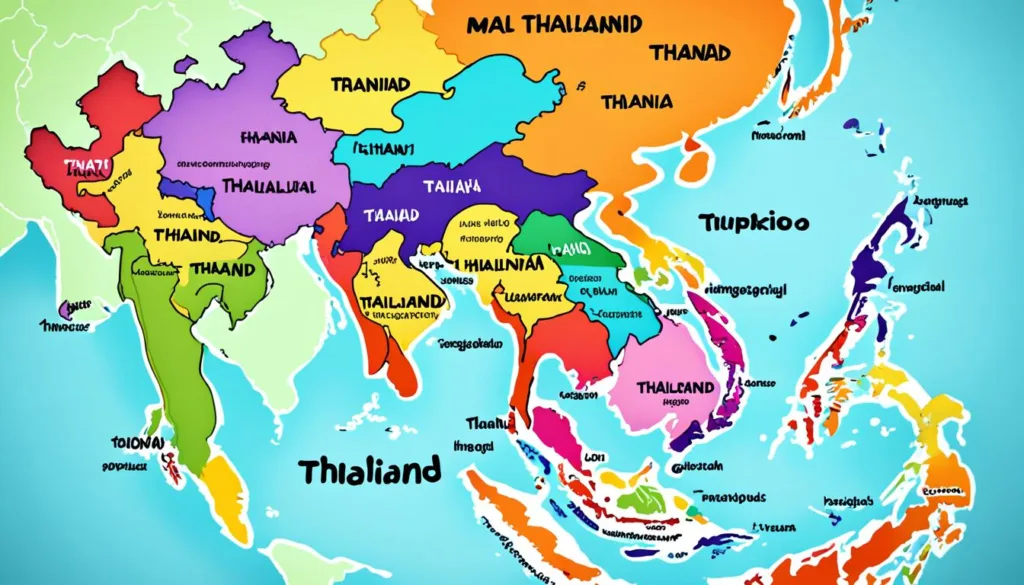
In the rich tapestry of Thailand’s cultural heritage, indigenous languages stand as testaments to the country’s diverse ethnic background. While the dominant Central Thai language is prevalent in urban areas, many of Thailand’s indigenous tongues dot the rural landscapes, each holding a mirror to the cultural practices and traditions of its speakers.
Rural Versus Urban Language Distribution
The dichotomy between urban and rural language distribution in Thailand is clear. Cities like Bangkok are melting pots of global influence, substantially favoring Central Thai or international languages. However, moving towards the countryside, one can discover a constellation of regional languages Thailand has safeguarded in remote villages and small towns. Here, the indigenous languages of Thailand continue to flourish, unfurling their colors with undiluted authenticity.
In the northern hills, the Akha language echoes, and the deep south harbors the tonal melodies of Malay. These languages are living artifacts of Thailand’s cultural heritage languages, cherished by communities that strive to sustain their ancestral voice amidst the modern cacophony. While language preservation in Thailand faces an uphill battle against the tide of modernization, these indigenous dialects remain an integral part of the country’s rural identity.
Preserving Indigenous Languages in Thailand
The valiant efforts for language preservation in Thailand signal the country’s commitment to its cultural roots. Organizations and advocacy groups, often led by community elders and educators, play a pivotal role in archiving linguistic data, developing educational resources, and creating platforms for traditional language use in media and public forums.
Much like a delicate ecosystem, the balance of language use and preservation requires nurturing—care that comes in the form of revitalization projects. Languages such as Karen and Northern Thai witness this through dedicated radio stations, cultural festivals, and schools incorporating vernacular mediums of instruction. It’s a communal tribute to the linguistic legacy that is part and parcel of Thailand’s socio-cultural diversity.
Language revitalization is not merely an academic endeavor; it is an act of cultural affirmation. The continued use and celebration of indigenous languages ensure that the wisdom of older generations is passed on, keeping the narrative of Thailand’s people vibrant and pulsating through the ages.
| Language | Region | Numbers | Revitalization Efforts |
|---|---|---|---|
| Akha | Northern Thailand | Approximately 80,000 | Cultural preservation programs and community radio |
| Karen | North and West Thailand | Over 400,000 | Educational materials development and native language schools |
| Malay | Southern Thailand | Approximately 1.5 million | Local television channels and cultural events |
| Northern Thai (Kham Muang) | North Thailand | Over 6 million | Literary projects and traditional arts promotion |
Thailand’s Melting Pot: Immigrant and Expatriate Languages
Thailand’s cultural landscape bears the colorful footprints of myriad languages brought in by a vast immigrant and expatriate community. The influence of immigrant languages in Thailand is notably seen in urban neighborhoods and business districts, where transactions and daily communications often occur in a tapestry of tongues ranging from Burmese to Vietnamese. Furthermore, the presence of various Chinese dialects and the articulations from the Indian subcontinent add to the country’s linguistic fabric, showcasing Thailand as a diverse and welcoming nation.
The contributions of expatriate languages in Thailand are equally significant, enhancing the cosmopolitan feel in areas like Bangkok, Chiang Mai, and Phuket. Here, English operates not just as a global lingua franca but as a bridge connecting the Thai people with the wider world. The influx of languages such as Japanese, Korean, and a ensemble of European languages reflects the varied backgrounds of the expatriates and international workers who have chosen Thailand as their home.
The rich interplay of languages in Thailand’s melting pot fosters an environment of cultural exchange, promoting a unique blend of heritage and modernity. This linguistic diversity is not just a testament to the country’s international ties but also underlines the nation’s role as an epicenter for cultural integration in Southeast Asia.
Thailand, with its emblematic warmth and hospitality, embraces these immigrant and expatriate languages, acknowledging them as integral threads in the nation’s vivid tapestry. The cosmopolitan cities sparkle with linguistic variety even as the distinctive tones of each language echo throughout malls, streets, and corporate corridors, painting a vibrant picture of Thailand’s ever-evolving cultural identity.
Sign Languages in the Thai Deaf Community
The importance of recognizing the various sign languages within the deaf community in Thailand cannot be overstated. As a critical means of communication, Thai Sign Language (TSL) acts as the principal conduit through which the deaf community in Thailand can engage with each other and the society at large. TSL, which has roots in the country’s indigenous sign languages and American Sign Language (ASL), represents a lifeline for deaf communication in Thailand.

Diversity and Recognition of Thai Sign Languages
In the rural expanses of Thailand, unique sign languages have surfaced, evolving naturally within deaf communities. These languages are rich in culture and history but often lack formal documentation or recognition. The diversity within these communicative forms illustrates a broader spectrum of deaf communication in Thailand that is yet to be fully explored and appreciated.
Challenges and Support for the Deaf Community
Despite the natural development of TSL and other sign languages, the Thai deaf community is faced with significant challenges. Limited resources, societal support, and recognition form barriers to effective integration and access. However, the infusion of sign language support through various organizations and the inclusion of TSL in educational programs are potent actions towards surmounting these obstacles and empowering the deaf community.
| Sign Language in Education | Community Advocacy | Resource Allocation |
|---|---|---|
| Inclusion of TSL in school curricula | Grassroots movements for language rights | Government and NGO funding for TSL resources |
| Teacher training in Thai Sign Language | Public awareness campaigns | Creation of TSL teaching materials |
| Certification programs for sign language interpreters | Partnerships with deaf advocacy organizations | Development of accessible communication tools |
The potential of sign languages within this spectrum remains a testament to the resilience and vibrancy of the deaf community in Thailand. It’s through the ongoing dedication to recognizing and supporting these sign languages that a more inclusive Thai society will emerge.
The Impact of Globalization on Language in Thailand
As the forces of globalization forge increasingly interconnected societies, the linguistic tapestry of Thailand is undergoing significant transformation. The twin engines of tourism and international commerce have particularly influenced the landscape of language in this vibrant nation, further necessitating the incorporation of various global languages into the fabric of Thai society.
Influence of Tourism and International Business
Tourism, a vital sector of Thailand’s economy, is a significant catalyst for change in the country’s linguistic priorities. Visitors from around the world flood Thai cities and beaches, bringing with them a myriad of languages, with English, Chinese, and Japanese often heard in popular tourist destinations. Businesses too have recognized the advantage of embracing foreign tongues, with cross-border trade negotiations and international partnerships elevating the need for multilingual proficiency among Thai professionals.
Foreign Languages in the Educational Curriculum
Recognizing the influence of globalization on language, Thailand’s education system has responded proactively by integrating foreign language learning within its curriculum. English has secured a place at the forefront of this academic evolution, serving as a lingua franca for global communication. Other languages such as Chinese, owing to the sheer number of Chinese tourists and investors, and Japanese, given the extensive presence of Japanese businesses in Thailand, have also permeated schools and universities. These educational trends underscore the commitment to preparing Thai students for a future where global connectivity is a norm.
| Language | Role in Tourism | Role in Business | Presence in Education |
|---|---|---|---|
| English | Primary communication for services and attractions | Standard for international deals and corporate communication | Widely taught; emphasis on conversational and business English |
| Chinese (Mandarin) | Increasingly used in tourist hotspots; signboards, guides | Important for trade with China, investment opportunities | Growing interest; offered in schools and language institutes |
| Japanese | Used in specific tourist areas; dedicated accommodations | Critical for liaisons with numerous Japanese companies in Thailand | Offered as a secondary foreign language in many institutions |
The sweeping wave of globalization’s impact on language has undeniably affirmed foreign language learning as an indispensable aspect of Thailand’s progression. The symbiosis between the growth in Thailand tourism languages, the responsiveness of Thailand’s educational languages to global market needs, and the practical advantages of foreign language learning manifests a dynamic pathway leading Thai society into a future rich with multicultural exchange.
Conclusion
In summary, the languages spoken in Thailand paint a portrait of cultural richness and diversity. Central Thai stands at the core of this linguistic tapestry, underpinning the framework of national communication. Yet, the full spectrum of Thailand’s linguistic heritage is far more intricate, with each regional dialect and minority language weaving its unique cultural thread into the nation’s identity. It’s this interlacing of locally-spoken tongues with those brought by global currents that continue to shape the linguistic landscape of Thailand.
The nation’s linguistic heritage is not only a testament to its historical complexity but also represents its ongoing cultural dialogue. As global influences permeate the country, new languages are introduced, adding layers to an already vibrant linguistic scene. The challenge and opportunity lie in nurturing this evolution while also preserving the myriad of indigenous voices that form the bedrock of Thailand’s cultural and social makeup.
Moving forward, it’s crucial to acknowledge and protect this wealth of linguistic variety. The languages spoken in Thailand are more than mere tools of communication—they are living emblems of the country’s storied past and pillars of its dynamic future. Embracing this diversity ensures that Thailand’s linguistic legacy continues to resonate through generations, celebrating a world where every voice has the chance to be heard.
FAQ
What are the main languages spoken in Thailand?
The main languages spoken in Thailand include Central Thai (official language), Isan (Lao dialect), Northern Thai (Lanna dialect), Southern Thai, and various minority languages such as Akha, Karen, Malay, and others.
Is English widely spoken in Thailand?
English is not as widely spoken by the general population but it is commonly used in the business, tourism sectors, and larger cities, especially Bangkok. Additionally, English is taught in schools and is increasingly becoming a part of the Thai educational curriculum.
Are there different dialects of Thai within the country?
Yes, there are various regional dialects within Thailand, including Isan in the Northeast, Northern Thai in the North, Southern Thai in the South, and the standard Central Thai that is used in official settings and taught in schools throughout the country.
How does ethnic diversity influence language in Thailand?
Ethnic diversity has a significant influence on the linguistic landscape of Thailand. Many ethnic groups maintain their own languages, which adds to the rich tapestry of languages spoken in the country including numerous minority and indigenous languages that reflect the heritage of these communities.
What measures are being taken to preserve minority languages in Thailand?
Thailand recognizes the importance of preserving minority languages, and there are efforts towards documentation, education, and revitalization to maintain these languages. This includes publishing materials in minority languages and supporting cultural events that promote linguistic diversity.
What role does Central Thai play in the country?
Central Thai, also referred to as Siamese, is the official language of Thailand and plays a dominant role in education, government documentation, and national communication. It is understood nationwide and serves as the primary medium of instruction in schools.
Does Thailand have indigenous sign languages?
Yes, Thailand is home to various sign languages, including the Thai Sign Language (TSL), which is the national sign language used by the Thai deaf community and is influenced by American Sign Language. There are also unique village sign languages in rural areas.
How has globalization affected the languages spoken in Thailand?
Globalization has increased Thailand’s use of foreign languages, especially in the tourism industry and international business. There is a growing emphasis on learning English and other foreign languages such as Chinese and Japanese, which are seen as crucial for global trade and communication.
Are there any language-related challenges faced by Thailand’s deaf community?
The deaf community in Thailand faces challenges related to societal support, resource availability, and acknowledgment of their sign languages. While Thai Sign Language is gaining recognition, especially in educational settings, more work is needed to integrate and empower the deaf community fully.
What foreign languages are becoming more popular in Thailand’s educational system?
Besides English, which is a mainstay in the educational system, other foreign languages such as Chinese, Japanese, French, and German are becoming increasingly popular in Thai schools, reflecting the country’s engagement in international relations and global exchanges.
